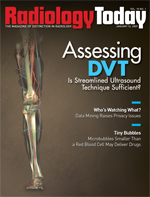
January 12, 2009
‘Pseudomasking’ — Is the Fox Guarding the Henhouse?
By Leslie C. Jenkins, RPA, RT(R)
Radiology Today
Vol. 10 No. 1 P. 38
When a facility moves to CR or DR, quality assurance management shifts from a central film processing area to individual scanning stations. Because these stations are not centralized like a film processing area, it’s not possible for the quality control manager to evaluate each radiograph as it comes from the processor as was done in years past.
CR software allows the technologist taking an image to crop the image and mask areas that aren’t of interest on a radiograph. Fujifilm CR users know this software tool as “shadow masking.” The icon on the General Electric CR system calls this technique “collimation.”
One potential risk of these software tools is that they allow the technologist to misuse them to mask mistakes and noncollimated images.
As an example, suppose your imaging department has a less-than-conscientious technologist who receives a request for an abdomen radiograph on a 5-day-old infant. When that image is exposed, we see everything from the upper abdomen of the child to below the baby’s knees, as well as the fingers of the nurse holding the baby.
To seemingly “correct” requires a few clicks of the mouse to mask the image and only show the requested anatomy. After this so-called pseudomasking, the radiograph looks beautiful, and the radiologist likely will be impressed with the quality of the film.
This is a pat on the back for the less-than-conscientious technologist. But what about the unnecessary exposure to the infant and the nurse?
In this way, the quality assurance managers and radiologists, responsible for protecting patients against overexposure to radiation, cannot evaluate the images for errors after they are sent to the central PACS system. It raises this question: Who is guarding the radiology henhouse?
Is the radiologist going to be happy when he or she is possibly called into court because an anomaly was imaged and then masked so it could not be seen? How responsible is the hospital or imaging center for the actions of a less-than-conscientious technologist who seems satisfied with the additional exposure and hides that it happened? Are we to the point in our profession that we accept these inadequacies?
According to the ACR Appropriateness Criteria’s relative radiation level information, the minimal effective dose estimate range for chest and hand radiographs is less than 1 millisievert. Of course, this is assuming appropriate collimation is observed at the time of exposure.
Also according to the ACR, “Certain patient groups require special attention with regard to radiation exposure. Radiation-induced cancer mortality risk in children is three to five times greater than for adults. Even though radiation levels required for imaging examinations of children are generally lower than those of adults, due to their smaller size (and assuming, again, proper collimation), it is particularly important to consider radiation exposure levels. When selecting and performing imaging examinations for children, consider their significantly elevated sensitivity to radiation exposure.” Adults would appreciate a little consideration when making exposures of those sensitive lumbar and sacral regions as well.
In an effort to keep the fox out of the henhouse, we suggest the following:
• Ask your vender to disable the pseudomasking feature completely, thereby removing the temptation to mask any flawed image.
• Establish a departmentwide policy that any image that is pseudomasked be annotated as masked, similar to the way a portable film is annotated with time and patient position. This way, the managers and the radiologist will know there is information available that is not being presented.
It is the responsibility of each radiology department and each individual radiologic technologist to assure the “as low as reasonably achievable” philosophy is utilized and to guard against any unnecessary radiation exposure to every patient. We have the trust of patients, radiologists, and other healthcare providers in our institutions to make sure everyone is exposed to the absolute lowest measure of radiation possible while producing a diagnostic-quality radiograph.
— Leslie C. Jenkins, RPA, RT(R) is a radiology practitioner assistant at the National Jewish Health Institute for Biomedical Imaging in Denver.

